Surely the residents of apartment buildings are a little jealous of those who live outside the city in a private building. Own living space, garden, clean air - everyone's dream. Alas, not everything is so simple, because the harsh Russian winters force us to carefully insulate the home in order to avoid freezing. This implies an impressive investment and constant monitoring of the condition. thermal insulation material, from which residents of city houses are exempt.
Home insulation is preferable to using a dozen heating appliances - you can save money, as well as make your home more comfortable. It is known that there are two ways to insulate a private building - outside and inside. Experienced experts recommend using both, but the primary thing is to take care of the external insulation. About what material is best suited for certain houses - below.
Requirements for thermal insulation material
The consumer is not in danger of a long search for good products - the market is saturated with goods different manufacturers, therefore, in any hardware store you can choose a decent insulation. However, before buying, it is necessary to analyze the material in question for its physical and chemical properties... These include:
- thermal conductivity coefficient (characterizes the ability of the insulation to conduct or hold air; the lower the indicator, the better - you do not have to use a thick layer of material)
- moisture absorption coefficient (indicates the ability of the material to absorb water as a percentage by weight; the higher the indicator, the less durable the insulation is);
- density (based on the value, you can determine how much the material will weigh down the house);
- resistance to fire (there are 4 flammability classes; the first one (G1) is the most preferable, which stops burning without an open source of fire);
- environmental friendliness (not the most important indicator for consumers, and in vain - to preserve the health of family members, you should choose only natural material from natural components, does not emit impurities into the atmosphere and does not contain synthetic elements);
- durability (the service life of the insulation set by the manufacturer);
- hygroscopicity (the ability to absorb vapor from the air);
- resistance to pests (insects, rodents, birds);
- noise insulation properties;
- ease of installation (the insulation should be fixed quickly, with a minimum set of tools; also a minimum amount of additional work should be done with it, such as cutting into even pieces).
It is difficult to choose a material that has all the desirable qualities. For this reason, it is possible and necessary to carry out insulation outside and inside.
Advantages of external thermal insulation
The question of insulating a private house from the outside arises in two cases - at the design stage of a building or when buying a finished one, but at the same time does not have decent thermal insulation. The second situation is more common. What are the advantages of insulating a home from the outside? These include:
- reduction of wall deformability due to additional protection;
- the facade perceives sharp temperature fluctuations; as a result, the service life of the structure will be extended;
- freedom in choosing the design of the facade, even when the building is erected;
- square indoor spaces remains unchanged; this allows you to carry out any kind of finishing, and the living conditions will remain the same.
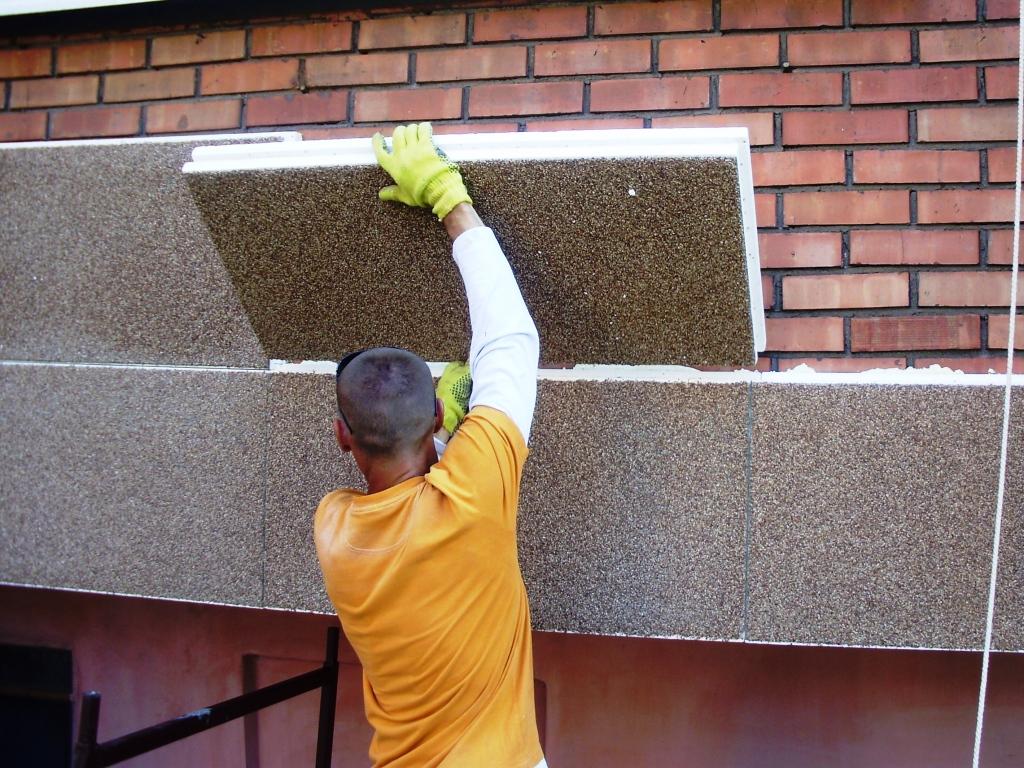
Ways to insulate the house outside
The need and advantages of thermal insulation from the outside are obvious; now the consumer should get acquainted with the methods of insulation. There are three of them:
- "Well" arrangement of the material;
- "Wet" glued insulation;
- ventilated facade.
In the first case, the insulation is placed inside the walls (for example, between layers of bricks). It turns out that he is "locked" among two levels. The method is effective, but it is impossible to implement it for an already built house.
In the second case, the layer of insulation is fixed to the glue outside the walls, then additionally attached to the dowels. Several types of coatings are applied on top - reinforcing, intermediate, decorative (finishing). A good way, it only requires the intervention of specialists; it is impossible to do wet wall insulation with your own hands without experience.
The ventilated facade resembles a "well" masonry, only outer layer facing material protrudes - drywall, tiles, siding, etc. Additionally, you will have to build a frame system for attaching sheets of heat insulator.
The last method is the most popular, widespread and profitable. It will be much cheaper than wet insulation; in addition, even a beginner can do the job with his own hands. Now the consumer is faced with the most difficult choice.
Existing materials can be divided into two large groups - organic (of natural origin) and inorganic (obtained using special materials and equipment).
Types and advantages of inorganic insulation
The first place on the list rightfully belongs to the most popular material - mineral wool. It is of three types - stone (basalt), glass and slag. Differing from each other only externally, varieties of mineral wool have the following qualities:
- low thermal conductivity coefficient (0.03 - 0.045);
- density variations (from 20 to 200 kg / m3);
- excellent noise insulation properties;
- vapor permeability (mineral wool can "breathe");
- fire resistance.
Not devoid of a number of disadvantages, including:
- attractiveness to rodents and insectoids;
- deterioration thermal insulation characteristics 50% when wet, only 3-5% of the volume;
- never completely dries out.
In general, mineral wool is good, but it is highly undesirable to use it for cladding a house outside.

The second known outdoor insulation is foam. Its pluses:
- the heat conductivity coefficient is slightly lower than that of mineral wool (0.03 - 0.037);
- costs less than other heaters;
- lightweight;
- density from 11 to 40 kg / m3.
- fragility;
- release of toxic substances during fire;
- does not "breathe", which forces residents to build additional supply and exhaust ventilation;
- when directly wet, it absorbs moisture, becoming unusable.
Extruded polystyrene foam is not inferior in thermal conductivity to mineral wool and foam. In addition, he:
- does not absorb moisture;
- convenient for installation, because it is produced in plates;
- stronger than polystyrene;
- almost does not allow air to pass through.
Disadvantages:
- flammable;
- emits harmful substances during combustion.
There is another type of raw material used for external thermal insulation walls of the house - "warm" plasters. They are a mixture of beads (formed by glass, cement and hydrophobic additives). "Breathe", isolate the room from moisture, do not burn, are not afraid of sunlight, are easy to repair. Not very common on the market, nevertheless, experienced consumers have already appreciated this insulation.
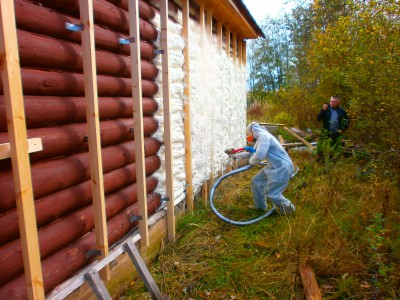
Varieties and benefits of organic materials
For those who want to feel the maximum closeness to nature, it is recommended to use raw materials from natural ingredients. These include:
- cork heaters - have a thermal insulation coefficient of 0.045 - 0.06; are crushed bark of a tree, pressed under the influence of hot steam and resin as a binding element; easy to cut, "breathe", do not form mold, non-toxic; today they are increasingly used to insulate walls from the outside);
- cellulose wool (ecowool) - thermal conductivity from 0.032 to 0.038; are crushed cellulose, treated with fire retardants to increase fire-fighting properties; properties resemble cork materials, but absorb liquid better; do not withstand heavy loads and are not suitable for wall cladding;
- hemp - supplied in slabs, rolls, mats based on hemp fibers; does not hold the load poorly, although it is quite dense (20-60 kg / m3);
- straw is an old way to insulate the walls of a house; breathable material treated with flame retardants to reduce flammability; practically not used today;
- seaweed - an exotic method of covering external walls; density up to 80 kg / m3, do not burn, do not rot, do not arouse interest in rodents, are resistant to mold and mildew. Better for light walls.
Preferred home insulation materials
Each material has pros and cons. Based on the information presented above, you can make a symbolic rating of the highest quality materials for the walls of the house (the first is the most preferable, etc.). It is also worth considering the type of facade design.
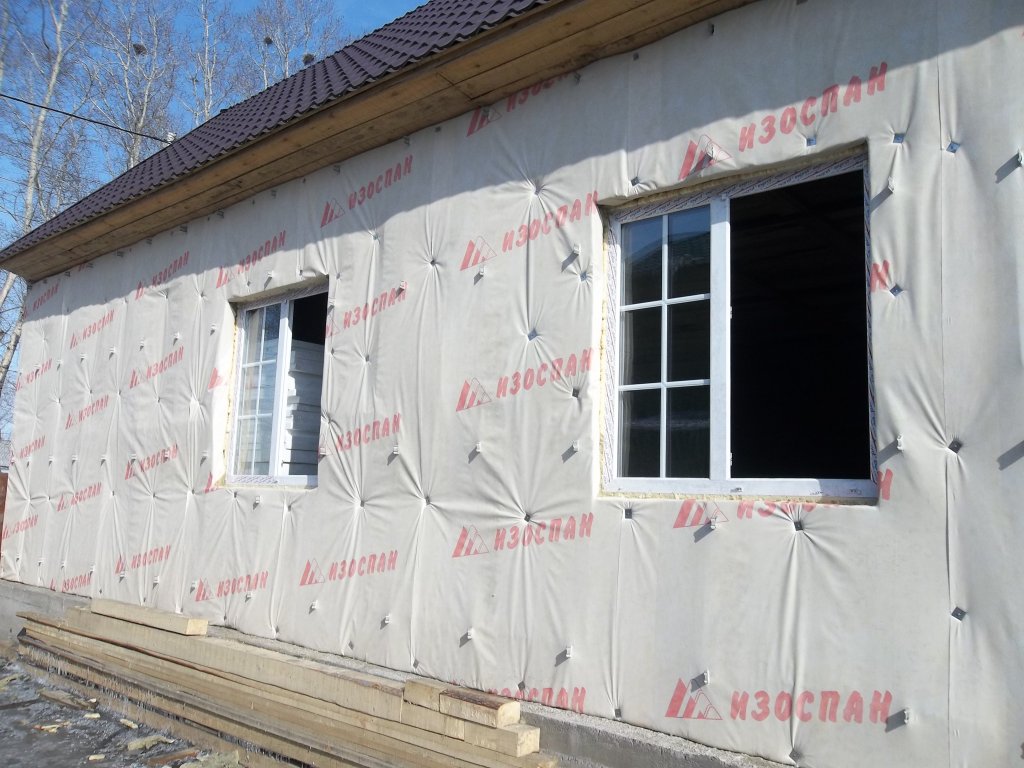
For ventilated systems, wool is better suited - mineral, cellulose. When laying wells, preference is given to material that does not allow moisture to pass through. This is extruded polystyrene foam. Plaster finishing walls go well with insulation, whose density is more than 30 kg / m3. For example, with mineral wool, EPS, foam, any organic material.
For light walls of a wooden house, a breathable material is better suited - mineral wool, hemp, ecowool, cork insulation. The first is preferable, but costs a little more.
A country house should be high quality sheathed with reliable material. The consumer can choose any of those discussed earlier, guided by their wishes or financial capabilities. A competent approach to the purchase of insulation is a guarantee of a long service life of a cozy home.
The facade of residential buildings cannot always withstand winter frosts and piercing winds, which makes you feel cold inside the building. Insulating a house from the outside will help protect the building from moisture, keeping hot air indoors. In the article, you will learn what wall insulation is outside, how to increase the temperature inside a wooden house, and what is the difference between thermal insulation with mineral wool and foam.
What is wall insulation
A common way to save energy is insulation - thermal insulation for walls outside or inside a building, made with special materials. By insulating the façade of the apartment, you will get rid of the fungus, increase the noise protection, and establish thermoregulation - it will be cool in summer and warm in winter. Insulation not only becomes a barrier between cold air and the internal microclimate of the home, but also protects the building from moisture and sun, increasing its service life.
Ways to insulate walls outside
Distinguish between internal and external insulation of the walls of the house. The second type of thermal insulation is more effective than the first, since it does not reduce the area of \u200b\u200bthe room, it removes condensate from interior walls, keeps warm longer. There are four methods of facade thermal insulation:
- facing - a method that combines thermal insulation with decorative trim;
- hinged - an expensive method in which insulated structures made of steel sheets and a layer of cladding (plastic siding, wooden lining, blockhouse);
- "Wet" - a method that assumes in fixing polystyrene to the facade using glue, applying a mesh, finishing primer and plaster;
- spraying liquid insulation - polyurethane foam is sprayed onto the facade, a decorative coating or hinged panels is applied to it.
Home insulation
Up to 50% of home heat is escaping through the wall facade, so house insulation is a necessary procedure for those who want to maintain a comfortable microclimate in their homes and save on electricity. When choosing a heater for the walls of a house outside, you should focus on the wall material, since different insulation technologies are used for concrete, brick, wooden and block structures. It is cheaper to insulate a private house than an apartment in a multi-storey building.
Insulation of apartments
If you live in apartment building with a central heating system, insulation of the apartment from the outside is the best option, which will help to avoid additional costs for maintaining a comfortable temperature in the room with the help of electricity. By insulating an apartment, you can solve the problem of sealing joints in panel skyscrapers. Not all inhabitants multi-storey building agree to insulate their home, so often apartments are insulated pointwise, which can lead to the destruction of the main wall at the joints with the insulated surface.
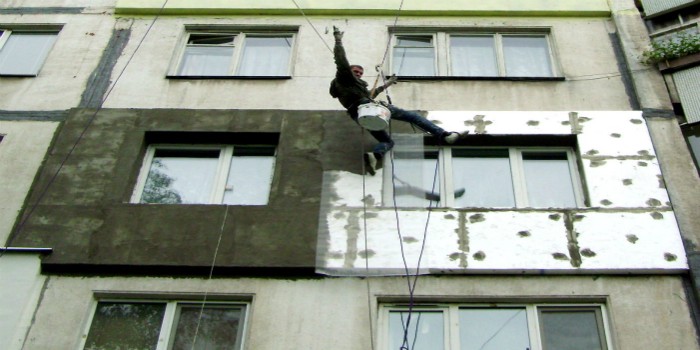
Insulation for walls
You should choose the right materials for wall insulation outside, taking into account what the building is built from, how many floors there are, what are the climatic features of the area. The microclimate of the room depends entirely on the choice of materials and the quality of installation. Heaters are distinguished according to the following criteria:
- thermal conductivity;
- durability;
- fire resistance;
- soundproofing;
- air tightness;
- waterproofness;
- environmental safety;
- biostability.
External insulation gives desired result, only if the thermal insulation materials fit tightly to the frame of the room, without air gaps. There are such types of insulation for walls outside:
- styrofoam;
- mineral wool;
- expanded polystyrene;
- polyurethane foam;
- basalt slabs;
- cellulose.
Foam insulation
Wall insulation with foam plastic is gaining more and more popularity. This material is lightweight, inexpensive, easy to work with. The obvious pluses of foam are moisture resistance, high sound insulation, excellent thermal insulation properties. The disadvantages of the material are the ability to ignite with the release of toxic substances, fragility, poor air permeability. Before installation, you need to draw horizontal lines of the working surface, which will become the lower and upper edges of the placement of the insulation. The foam is fixed to a special adhesive solution.
Mineral wool insulation
A common method of thermal insulation is wall insulation with mineral wool. It is a fibrous material made from mineral raw materials, non-combustible, good air permeability. Minvata is suitable for installation on all types of building structures. The material is resistant to corrosive substances, but absorbs water, so it needs a special waterproofing system. Mineral wool has a long service life - up to 70 years.
Warming with expanded polystyrene
One of the best methods of thermal insulation is the insulation of the building from the outside with pressed polystyrene foam, the second name of which is "Penoplex". The material is slightly denser than polystyrene, less flammable, durable. Expanded polystyrene is waterproof, resistant to deformation. One of the downsides is poor sound insulation. Penoplex is produced in the form of plates, which must be fastened without gaps in order to protect the insulation from damage by rodents.
Wall insulation with polyurethane foam
Thermal insulation of the house outside with polyurethane foam is carried out by spraying the material onto the prepared facade. The use of this substance as insulation has the following advantages:
- expanding material fills cracks and small depressions;
- polyurethane foam has good adhesion - it adheres perfectly to the base, covering the surface without joints, with a continuous layer;
- the substance becomes strong after hardening;
- it has increased moisture resistance;
- polyurethane foam serves as an excellent sound insulator.

Warming with basalt slabs
Reliable insulation of the outer walls of the house is provided by environmentally friendly basalt slabs made of mineral wool. The material does not catch fire, has excellent windproof and cold-resistant properties, does not accumulate moisture. The implementation of thermal insulation with basalt slabs allows for almost any facade decoration. Installation of the material has a simple technology, so you can do it yourself. The outer thickness of the material is deceiving - you can even cut it with a kitchen knife.
How to insulate a house from the outside and what
External wall insulation will significantly reduce heat loss inside the room. The choice of materials and technology for thermal insulation depends on the specific conditions - the house is made of brick or wood, the attic or basement will be insulated. Having insulated the facade correctly, you will make your house warm, protect the room from the formation of fungus, mold, dampness and isolate the home from extraneous street noise.
How to insulate a wooden house from the outside and what
A house made of wood has some advantages over a stone house or a brick building - the cost is lower, the environmental friendliness is higher. The main disadvantages are: low thermal conductivity of the timber, small wall thickness and the presence of cracks between them. Insulation of the walls of a wooden house can be carried out by building a hinged ventilation facade with mineral wool, spraying polyurethane or sheathing the facade with expanded polystyrene. When insulating a country house made of wood, you need to take care of a vapor barrier and waterproofing. Insulation for the outer walls of the house will allow:
- transform the facade;
- protect the tree from the adverse effects of the environment;
- increase thermal efficiency;
- save the internal space of rooms;
- prevent the occurrence of dampness, mold;
- protect from cold winds.
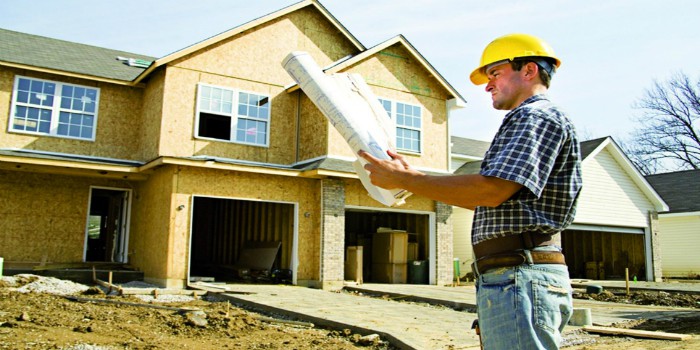
Insulation of a brick house from the outside using modern methods
To in the house whole year a stable comfortable temperature was maintained, it is recommended to insulate the brick walls from the outside. When choosing a heater, one should take into account what kind of brick the building is built from (hollow, solid, ceramic, silicate). Brick houses often they are insulated using a hinged ventilated facade or a “wet” method. Mineral wool, polystyrene foam, expanded polystyrene are used as insulation.
How to insulate the walls of the house outside inexpensively
Often people wonder how to cheaply insulate a house from the outside. If you don’t know the cheaper it is to insulate the house from the outside, pay attention to the foam. This insulation, perhaps, is slightly inferior to others in terms of thermal insulation, but it does a good job of maintaining a comfortable temperature. The material has excellent thermal conductivity and moisture resistance, its main disadvantage is flammability. It is easy to work with polystyrene, so you can buy material and try to insulate the house yourself, saving also on paying for the work of the craftsmen.
Price for wall insulation outside
Thermal insulation of housing is not a cheap pleasure. If we calculate the cost of heating a building with electricity, it becomes clear that the price of the service will soon pay off. The calculation of the cost of thermal insulation is carried out taking into account the selected materials, the complexity of the work, the size of the insulated area. Find out in the table below how much it costs to insulate a house outside in Moscow, and how the price of the service differs in different construction companies.
Owners of private houses often ask themselves which wall insulation is the most effective outside. What is the best insulation to choose so that the supporting wall structures do not conduct the cold in winter and repel the heat in the sultry summer. Many modern thermal insulation materials not only prevent heat loss in the cold season, but also protect the room in summer from the penetration of thermal radiation. The issue of thermal insulation of your home must be approached with all seriousness. How high-quality you make the thermal insulation system for your home depends on how comfortable and cozy home will be for its tenants.
External wall insulation
Thermal insulation materials, types and characteristics
Previously, organic insulation in the form of sawdust, peat, etc. was used to insulate the building structure. A significant disadvantage of these materials was their combustibility, a high rate of moisture absorption, susceptibility to rotting and mold formation.
On this moment organic heaters are practically not used for thermal insulation at home. Now the construction market offers a wide range of synthetic thermal insulation materials with the best technical characteristics.

Expanded polystyrene, its advantages and disadvantages
Most people, when deciding how to insulate a house from the outside, prefer expanded polystyrene. Such popularity of this insulation is due to its low cost and excellent performance.
It is especially worth noting the following advantages of expanded polystyrene:
- lower, in comparison with mineral wool insulation, thermal conductivity (this allows the thickness of the insulation layer to be made smaller);
- affordable cost (expanded polystyrene is cheaper than mineral wool);
- ease of installation (this material lends itself well to processing).
The disadvantages of expanded polystyrene include: lower vapor permeability, in comparison with mineral wool insulation, and higher flammability.
Expanded polystyrene, despite some of its shortcomings, is widely used for facade insulation. The use of this material for thermal insulation of a building is three to four times cheaper than the use of other insulation, in particular mineral wool.
Important! Due to its low vapor permeability, polystyrene foam is not recommended for insulation wooden houses... Its only area of \u200b\u200bapplication is the insulation of stone facades.
Expanded polystyrene is very effective for insulating brick houses. Foam polystyrene insulation with a thickness of only 80 mm makes it possible to reduce fuel consumption by four times in the cold season.
Foil insulating material
A rather interesting modern insulation is a foam-foil insulation. It is a layer of polyethylene foam, which is clamped on both sides with aluminum foil. The peculiarities of this material are light weight and low thermal conductivity (the thermal conductivity of this insulation is 1.5 times less than that of basalt insulation).
The advantages of this material include ease of installation, the insulation is attached to the walls with a construction stapler. Among the shortcomings, it is worth noting the absolute vapor and gas tightness.
Insulation pressed cork
Such a rather exotic insulation like pressed cork is made from the bark of cork oak growing in the Mediterranean. This insulation is produced in rolls and plates, has a very attractive appearance, and is an environmentally friendly material. Pressed cork is used for internal wall insulation, this material, due to its excellent appearance, also performs the functions decorative finishing... Cork slabs can also be used for external insulation of facades.
Rock-based mineral wool
A distinctive feature of mineral wool fibers is its ability, without melting, to withstand temperatures above 1000 °. Thanks to this, mineral wool prevents the spread of fire and protects the structures of houses built from combustible materials from fire (for example, wooden houses). Heaters with high water absorption rates lose their heat-insulating properties, since water entering the heat-insulating material fills the air pores and increases the thermal conductivity of the insulation. Mineral wool practically does not absorb moisture, therefore it remains dry and retains the properties of low thermal conductivity, even if moisture gets on its surface.
The numerous advantages of mineral wool also include high resistance to mechanical stress.
Fiberglass thermal insulation materials
Fiberglass materials can be used to insulate the house outside. The main components used to make fiberglass are cullet, sand, dolomite, limestone, soda, ethybor, etc. The raw material for fiberglass is melted in a melting furnace at 1400 ° C and fed to the front hearth, where it undergoes fiberization. In centrifuges, molten glass breaks down into 6 micron fibers. After that, the resulting products are impregnated with polymer resin and fed to the conveyor, where they are formed into mats. The remaining water is evaporated from the mats and a high-quality insulation is obtained.
Fiberglass materials have best qualities for thermal insulation of building facades, which include:
- Fire safety.
- Cost-effective transportation.
- Ease of installation.
- Low coefficient of thermal conductivity (from 0.035 to 0.044 W / mK), due to the ability of fiberglass to hold air firmly, and, as a result, excellent thermal insulation properties. Fiberglass insulation can reliably protect against cold in winter and heat in summer.
- Resistant to moisture. Due to its non-hygroscopicity (glass wool does not absorb water), the heat-insulating properties do not deteriorate when moisture gets on the material.
- Environmental friendliness. Fiberglass insulation does not emit harmful substances and is safe for health, mold and rot do not form on it.
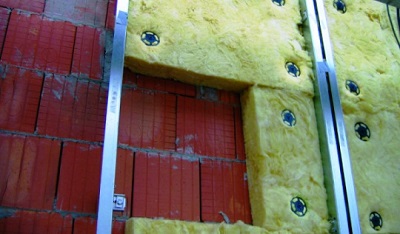
Glass wool is an effective insulation
What is better for thermal insulation of walls from the outside: mineral wool or expanded polystyrene
Mineral wool and expanded polystyrene are the most demanded heaters for thermal insulation of walls from the outside. Installation of mineral wool slabs is similar to the technology of styrofoam laying, in addition, these two heaters have similar specifications, therefore, when they decide what is better to insulate the house from the outside, first of all, these two heaters are compared.
When they want to cheaply insulate the walls from the outside, in most cases they choose polystyrene boards. This material is not only cheaper in itself than mineral wool, but its installation does not require special skills or complex tools; almost every owner can do the installation of thermal insulation using foam plates with his own hands. But when installing cheap foam insulation of walls from the outside, one should not discount that this material has a small mechanical strength. In addition, rats and mice are very fond of gnawing foam.
To insulate facades, manufacturers produce special types of vapor-permeable foam with a compacted outer layer. But the cost of such material is not less than the cost of mineral wool.
Insulation such as extruded polystyrene foam is not suitable for insulating walls from the outside, as it has zero vapor permeability. Using it to insulate facades leads to dampness of the material from which the walls are erected. Mold and fungi appear on the surface of the walls from moisture. On the market, you can buy vapor-permeable perforated extruded polystyrene foam intended for external insulation of facades. But their price is not less than the cost of mineral wool insulation.
When using expanded polystyrene for external wall insulation, it is better to purchase material with atypirens, these are special substances that prevent the material from burning. Polyfoam with a fire retardant acquires fire-fighting properties.
Mineral wool is not flammable, it resists mechanical stress well, it has sufficient vapor permeability, therefore, for external wall insulation it is more preferable, but with the correct design of the thermal insulation system, foam plates will also cope well with their functions.
It is better to use the lining of thermal insulation inside the house only as additional measure... If the outer walls are not protected from the cold, during insulation inside the house, condensation will constantly form in the room, which will contribute to the development of fungus and mold in the walls.
Dew point
The dew point is the temperature at which steam turns into water. Condensation occurs at the heat-cold interface. In our case, it will appear in the place where the unheated wall comes into contact with the warm air coming from the room. Moreover, the greater the difference between the wall temperature and the indoor temperature, the more condensation will be.Dew point in the wall of the house
If the house is insulated from the outside, when additional thermal insulation is installed inside the house, there will be no sharp temperature drop, so the amount of condensation inside the room will be minimal. But it will still accumulate.
To prevent the walls from getting wet after insulation, to lay internal thermal insulation should not only choose the right materialbut also take steps for the perfect sealing joints... To avoid condensation, it is better to insulate only separate sections of the walls on the leeward side, ends and corners.
Choice of materials
For internal insulation, you should not choose materials that have a high degree of moisture absorption: mineral wool, cork, warm plaster or drywall. The last two materials can only be used as a finishing layer.Porous penoplex does not absorb moisture, but has a low vapor permeability, so it can only be used if the quality of the seams is ideal. If the thermal insulation layer is leaky, between the wall and finishing material condensation will form.
The air permeability of the foam is higher, in addition, it is very problematic to achieve perfect joining with the wall using this material, therefore it is better not to use it for interior wall decoration or choose increased strength foam.
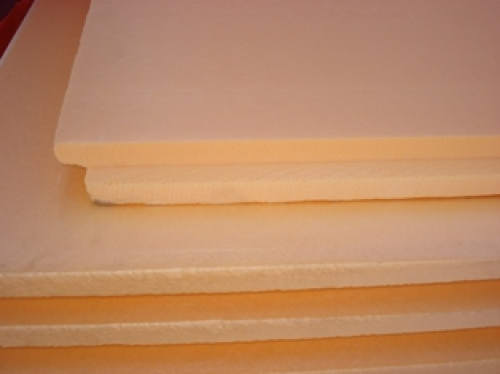
Penoplex
Preparing the walls
Before gluing heat-insulating materials, the walls must be completely cleaned of old wallpaper, paint and loose plaster. To do this, you can use a metal brush, a hair dryer or a grinder with a special attachment. In the presence of mold or mildew, these areas are additionally treated with antiseptics after cleansing.In order to avoid the appearance of cold bridges and the formation of condensation, all existing cracks should be completely sealed with foam or mortar. The protruding parts of the wall, which do not allow the thermal insulation material to be laid evenly, get lost. Too large dents are smoothed out with mortar.
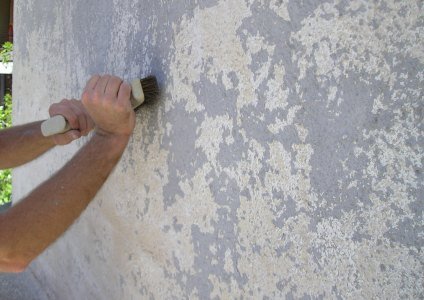
Cleaning the walls
All holes and gaps between the wall and the window are also carefully sealed with polyurethane foam. After it hardens, the remnants are cut off with a knife.
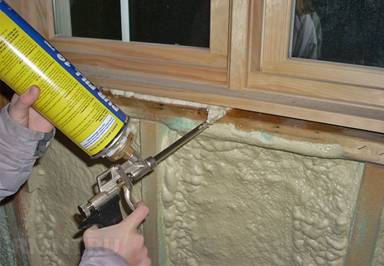
Sealing gaps with foam
Padding
Applying a layer of primer will reduce the vapor permeability of the walls, strengthen the surface and increase the degree of adhesion to the adhesive. In addition, this treatment will prevent the development of the fungus.For priming, deep penetration compounds should be selected. For wood processing, it is better to choose alkyd mixtures. The acrylic primer is versatile and can be used on all types of surfaces. Epoxies are used only for processing concrete and brick walls.
The primer is applied twice. The second layer is applied only after the first has dried. Smooth walls can be primed with a roller. If there are a lot of dents and chips, it is better to use a regular brush, the bristles of which can penetrate even the smallest cracks.
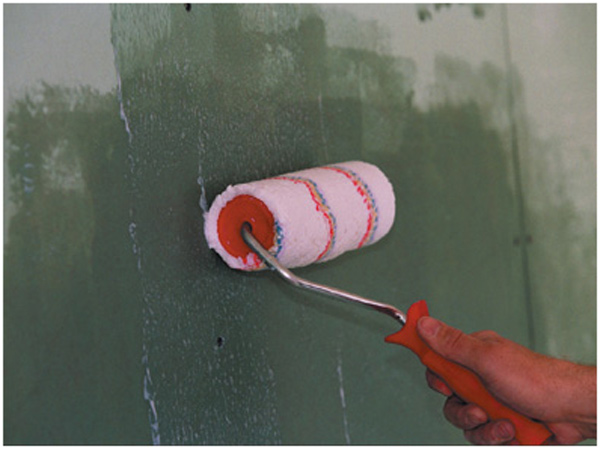
Wall priming with a roller
Vapor barrier film laying
Before installing the insulation, a foil material that reflects heat, or a thick plastic film, is fixed on the wall. They are fixed to wooden bars or a profile using staples, tape or mounting glue. Foil material is stacked shining side outside, to the room.All joints are glued with construction tape. In places of adjoining building structures and their pipes are additionally treated with a liquid sealant and fixed with a stapler.
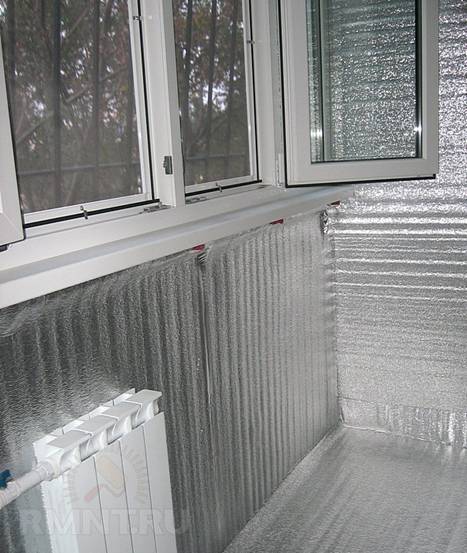
Finishing with foil insulation
The film or foil material is overlapped, while the joints of the canvas should fall on the frame racks. A slight overlap is made on the adjoining walls, windows, ceiling and floor.
Installation of insulation
Unlike polystyrene foam, penoplex has not a rough, but a smooth surface, therefore, to increase its adhesion to the wall, it is processed before gluing needle roller or sandpaper.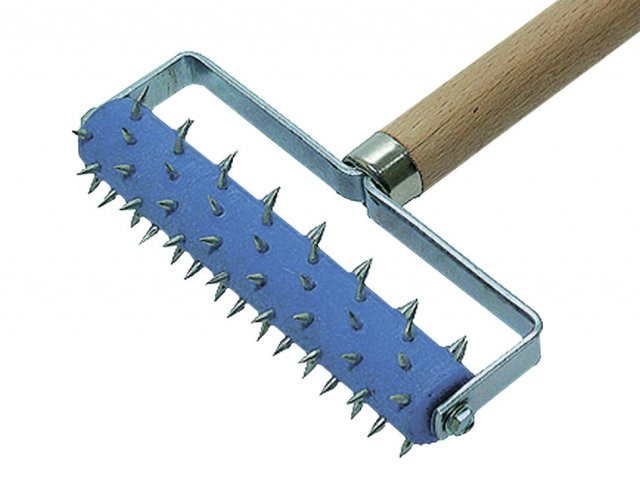
Needle roller
Small areas (space under radiators, slopes and window sills) are insulated first. Penoplex is well cut with a hacksaw or a sharp knife. To avoid damage to the material, it can be cut with hot wire.
Important! Work should be carried out in the summer after thorough drying of the room. The walls on which the thermal insulation material will be laid should be as dry as possible.
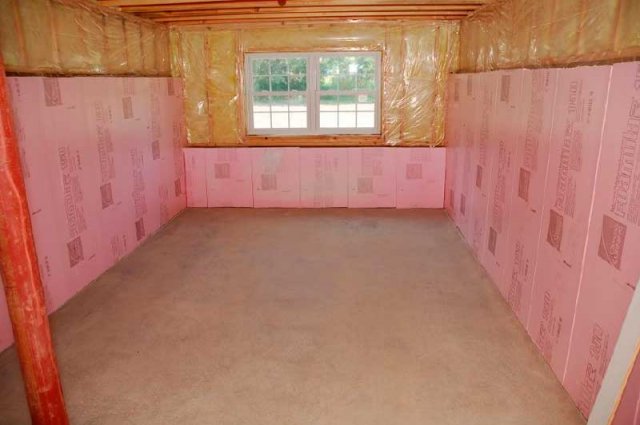
Wall decoration with foam
For fixing sheets to the wall, it is better to use a special adhesive compositiondesigned for working with penoplex. It is necessary to dilute it in small quantities: the dried mixture will crumble, and the thermal insulation will be broken. It maintains adhesion for 10 minutes - during this time, the foam sheet must be fixed to the wall.
The adhesive is spread evenly over the entire sheet using a notched trowel. For uneven walls, the adhesive can be applied in a thicker layer only along the center and perimeter of the sheet.
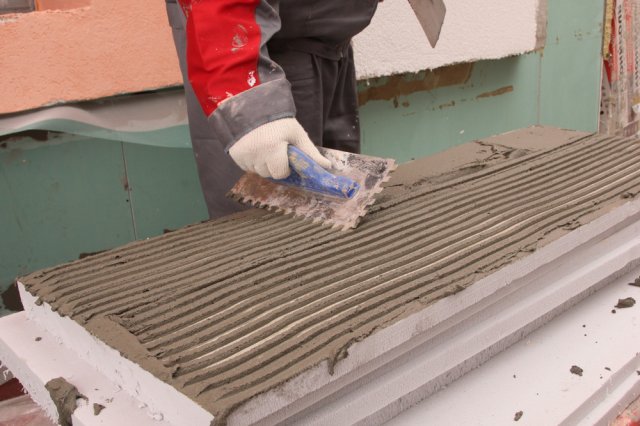
Oiling sheets
The sticker starts at the bottom of the wall. The sheets are joined together end-to-end. Unlike foam, foam has projections around the perimeter, so such a connection will be more tight. As a support for the bottom sheet, it is better to use starting metal rail-profile, which is fixed to the wall using dowels with washers.
The sheet is glued from bottom to top. It is firmly pressed to the surface, and then the excess glue is "expelled" from under the sheet. For offset (the penoplex is glued in a checkerboard pattern), the first sheet of the second row is cut in half. The correctness of the installation of the penoplex is controlled by the building level.
Important! The gaps between the penoplex are filled with scraps of material and glued. It is not recommended to use polyurethane foam for these purposes. In the process of expansion, it can lift the foam sheet, which will lead to a leak and the formation of cracks.

Fastening the penoplex
Additional fastening of sheets is performed using plastic "fungi"in which the dowels are inserted. To do this, holes are drilled in the wall through the insulation sheet: four in the corners of the sheet and one or two in its center. The dowels must go into brick wall to a depth of at least 90 mm, in concrete - by 50 mm. They are hammered with a rubber mallet.
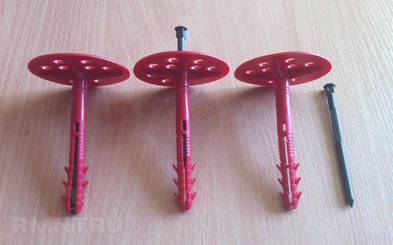
Plastic dowels
After insulation, drywall or reinforced foil can be attached to the wall and finished with decorative plaster.
Currently, when constructing new buildings, developers pay special attention to the thermal protection of the outer walls. This is required not only by building codes, but also by the desire to increase their competitiveness. However, the situation with walls in older houses is somewhat different. Owners of private houses have to carry out insulation of the premises with their own hands in order to keep the heat inside, and leave the cold outside.
There can be several reasons for the decrease in the temperature inside the house: a poor heating system, the presence of cracks, and drafts. However, the most common cause is poor wall insulation. Walls occupy the largest area in a room and are the main source of heat loss. There are several ways to insulate walls in a private house from the outside.
Why insulation should be done outside
- When insulating a house from the outside, the material protects the walls not only from heat loss, but also from the negative effects of moisture. Household heat warms up the wall and, in the event of moisture ingress and the formation of condensation, promotes its rapid drying.
- moves closer to the outer edge of the wall. This prevents condensation from forming.
- Do-it-yourself insulation of the house outside not only protects the room from the cold, but also preserves the useful area of \u200b\u200bthe rooms.
Wall insulation options outside
There are several options for how best to insulate a private house outside:
- Installation of heat-insulating material on the wall using an adhesive solution and further plastering.
- Formation of a three-layer non-ventilated wall. The insulation is fixed with a solution. Next, the outer wall is laid in one layer of brick, taking into account the air space.
- Installation of a ventilated facade. A heater is attached on top of the waterproofing, on which the windscreen is installed. The finishing stage is decorative clapboard or other siding.
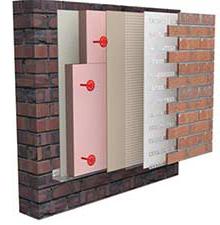 Each method has its own nuances in performance. There are combined materials, as well as modern modified ones, when installing which you should adhere to a special technology. Installation of a ventilated facade can be carried out even in the cold season, since its technology does not provide for the use of an adhesive composition.
Each method has its own nuances in performance. There are combined materials, as well as modern modified ones, when installing which you should adhere to a special technology. Installation of a ventilated facade can be carried out even in the cold season, since its technology does not provide for the use of an adhesive composition.
The better to insulate the house outside
There are several types of insulation material. Each of them has its own characteristics and price range. The following heaters are considered the most popular:
- styrofoam (expanded polystyrene, extruded expanded polystyrene);
- mineral wool;
- polyurethane foam;
- basalt slabs;
- cellulose-based insulation.
The correct insulation of the walls of the house outside with your own hands depends on the choice of the best option for wall insulation. The main differences between the above materials are vapor permeability, moisture resistance and thermal conductivity. The first two parameters are selected based on the characteristics of climatic conditions, as well as the mounting method to ensure maximum protection of the room from dampness. Thermal conductivity is taken into account when calculating the required thickness to achieve the optimal effect.
Calculation of the thickness of the insulation
Work on wall insulation from the outside should be started by calculating the thickness of the heat insulator. Calculations are carried out on the basis of SNiP, GOST and SP data. If you can't do the calculations yourself, it's better to use the services of private design organizations. The thickness of the insulation depends on the performance through the outer walls, window frames, foundations, ceilings and roofs. Taking into account the data obtained, and also taking into account the power heating system, calculate the thickness of the heat-insulating layer.
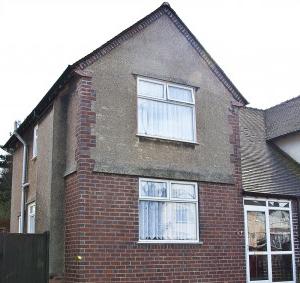 Next, they are determined with the choice of material and carry out the insulation of the house outside with their own hands. It is important to take into account not only the type and size of the heat insulator, but also the number of layers required. For example, it is better to refuse from expanded polystyrene if laying in several layers is required. For this, mineral wool or polyurethane foam, the thickness of which is much smaller, is suitable.
Next, they are determined with the choice of material and carry out the insulation of the house outside with their own hands. It is important to take into account not only the type and size of the heat insulator, but also the number of layers required. For example, it is better to refuse from expanded polystyrene if laying in several layers is required. For this, mineral wool or polyurethane foam, the thickness of which is much smaller, is suitable.
Preparing walls for insulation
After choosing the best way to insulate the house from the outside, they begin the main work. The main goal is to prepare the walls for further installation of the material. To achieve perfectly flat brick, wood or concrete surface the old layer of plaster or other insulator is completely removed.
Particular attention should be paid to priming the walls. If there are differences in levels on the wall (protrusions and depressions over 2 cm), it is better to seal them with a special solution or comb them to the desired level. Use a deep penetrating primer. Before applying the primer, the wall is cleaned of dust and dirt.
In order for the insulation for the walls outside to lay down in an even layer and not interfere with the construction of an external wall from decorative bricks or plastering, you should think over a system of plumb lines and lighthouses in advance. They are used to determine the plane of the outer edge of the insulation, which facilitates its installation.
Anchors or screws are installed to the upper edge of the wall. A strong thread is tied to them and lowered with plumb lines to the very bottom. Horizontal threads are attached between them, which form a control grid. It serves as a guide when installing the frame or installing insulation.
Installation of foam and extruded polystyrene foam (EPS)
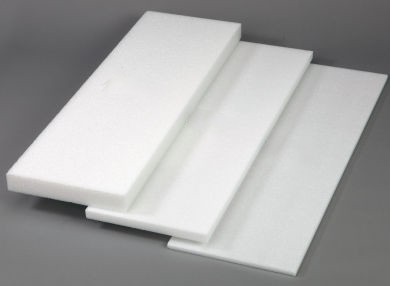 Styrofoam is attached to the wall with a special adhesive for expanded polystyrene boards. Sometimes construction "fungi" are used for these purposes.
Styrofoam is attached to the wall with a special adhesive for expanded polystyrene boards. Sometimes construction "fungi" are used for these purposes.
When insulating walls with EPS, the surface on which the glue solution will be applied is made rough. This contributes to a more reliable adhesion. There are no such problems with foam, since the glue fixes it without additional processing.
Often, both glue and "fungi" are used to strengthen the fastening. This is a more correct solution that extends the life of the insulation.
The final stage of wall insulation from the outside is the application of plaster or cladding with decorative materials.
How to insulate walls in a private house from the outside with foam using wooden battens
In practice, another method of attaching foam sheets is used - by forming a frame from wooden slats.
For the construction of the frame, slats are used, the thickness of which is not less than the thickness of the insulation. If the thickness is slightly greater, this will create a ventilated space between the insulation and the cladding material. The distance between the slats is calculated in such a way that the plates are tightly inserted into the niches and do not fall out.
This type of installation is acceptable if, for finishing walls will be used siding or clapboard. The slats will serve as the basis for attaching the facing material.
Mineral wool: fastening features
Mineral wool can also be used to insulate a private house from the outside. Materials and advice for performing work are similar to the instructions for fastening basalt slabs and cellulose-based insulation.
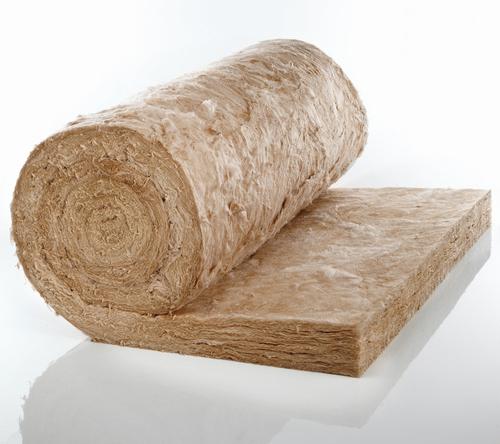 For a more reliable installation of mineral wool sheets, a frame system of wooden slats is formed. The width of the lathing should be 2-3 cm less than the width of the insulating material. This ensures that the mineral wool fits tightly between the beams and there are no gaps. Additionally, anchors are installed on which insulation sheets are subsequently put on. If the surface of the wall is uneven, two-layer mineral wool is used, the layers of which have different densities. The soft layer provides a secure grip on the wall.
For a more reliable installation of mineral wool sheets, a frame system of wooden slats is formed. The width of the lathing should be 2-3 cm less than the width of the insulating material. This ensures that the mineral wool fits tightly between the beams and there are no gaps. Additionally, anchors are installed on which insulation sheets are subsequently put on. If the surface of the wall is uneven, two-layer mineral wool is used, the layers of which have different densities. The soft layer provides a secure grip on the wall.
In terms of external finishing, mineral wool is more versatile, unlike other types of heat insulators. On top of the insulation, an external horizontal cladding can be installed, under which a windproof layer in the form of a dense polyethylene film is attached. For wall cladding, decorative bricks, lining or other siding are used. This technology allows you to create a three-layer ventilated insulation that is suitable for most climatic zones.
How to insulate walls in a private house outside with polyurethane foam
The installation principle of polyurethane foam is similar to the technology of fixing mineral wool. However, independently perform wall insulation using of this material almost impossible. The method involves the use of special expensive equipment that distributes the liquid mixture over the surface to be treated. In addition, without professional skills, working with the installation causes many difficulties.
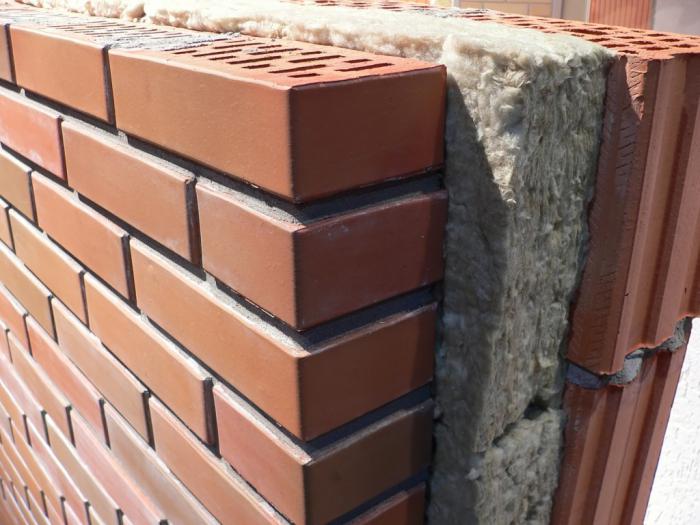 The main feature of this method of warming is the very fast execution of work. With the above installation, polyurethane foam is sprayed over the surface. As a result of a chemical reaction, a liquid substance is transformed into a solid state and foamed. The insulation does not form an air space between the wall and the heat insulator, which provides a stronger and more durable coating.
The main feature of this method of warming is the very fast execution of work. With the above installation, polyurethane foam is sprayed over the surface. As a result of a chemical reaction, a liquid substance is transformed into a solid state and foamed. The insulation does not form an air space between the wall and the heat insulator, which provides a stronger and more durable coating.
Features of polyurethane foam
Polyurethane foam has many benefits, including:
- after hardening, it fills all cracks and depressions;
- steam permeability is significantly lower than that of other materials;
- quickly and reliably fixed to the wall;
- excellent mechanical strength;
- good heat and sound insulation.
However, the cost of the material and its installation are quite expensive. Its durability and high quality indicators justify the high installation costs.
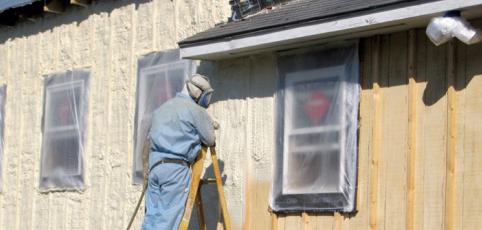 If sooner or later the question arises of how to insulate a house outside with your own hands, the instructions for using polyurethane foam will help solve the problem of heat loss and maintain a comfortable temperature in the room.
If sooner or later the question arises of how to insulate a house outside with your own hands, the instructions for using polyurethane foam will help solve the problem of heat loss and maintain a comfortable temperature in the room.
Regardless of what material is used as a heat insulator, any of the above options copes with its main task - the insulation of the room. In addition, the outer insulation allows you to keep warm and protect the surface from dampness. He will tell you how to insulate the walls in a private house outside step-by-step instruction and practical recommendations of specialists.



